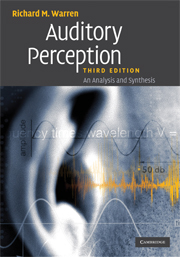Book contents
- Frontmatter
- Contents
- Preface
- 1 Sound and the auditory system
- 2 Spatial localization and binaural hearing
- 3 Perception of acoustic repetition: pitch and infrapitch
- 4 Judging auditory magnitudes: the sone scale of loudness and the mel scale of pitch
- 5 Perception of acoustic sequences
- 6 Perceptual restoration of missing sounds
- 7 Speech
- 8 The relation of hearing to perception in general
- References
- Index
4 - Judging auditory magnitudes: the sone scale of loudness and the mel scale of pitch
Published online by Cambridge University Press: 18 May 2010
- Frontmatter
- Contents
- Preface
- 1 Sound and the auditory system
- 2 Spatial localization and binaural hearing
- 3 Perception of acoustic repetition: pitch and infrapitch
- 4 Judging auditory magnitudes: the sone scale of loudness and the mel scale of pitch
- 5 Perception of acoustic sequences
- 6 Perceptual restoration of missing sounds
- 7 Speech
- 8 The relation of hearing to perception in general
- References
- Index
Summary
This chapter is concerned with the consequences of two broad principles applicable to hearing (as well as to perception in general): (1) there is an obligatory interpretation of sensory input in terms of events and conditions normally associated with stimulation; and (2) individuals are not aware of the nature of the neurophysiological responses to stimuli as such. The implications of these principles for the sone scale of loudness and the mel scale of pitch will be discussed, and evidence will be presented suggesting that the judgments used for the construction of these scales of sensory magnitude are based upon familiarity with physical scales correlated with the changes in stimulation.
Sensory input and perception
In the previous chapter on auditory localization, we saw how differences in acoustic input to the two ears are perceived in terms of associated external conditions and events without awareness of the aspects of sensory stimulation leading to this perception. Thus, when the sound radiated by a source reaches one ear before the other, listeners hear only a single sound located on the side of the leading ear: the difference in time of stimulation can be inferred by those having some knowledge of acoustics, but even then only one off-center sound is perceived. Also, we have seen that interaural spectral amplitude differences approximating those produced by the head and pinna for sources at different azimuths are perceived in an obligatory manner in terms of location rather than spectral mismatch.
- Type
- Chapter
- Information
- Auditory PerceptionAn Analysis and Synthesis, pp. 107 - 125Publisher: Cambridge University PressPrint publication year: 2008
- 1
- Cited by



